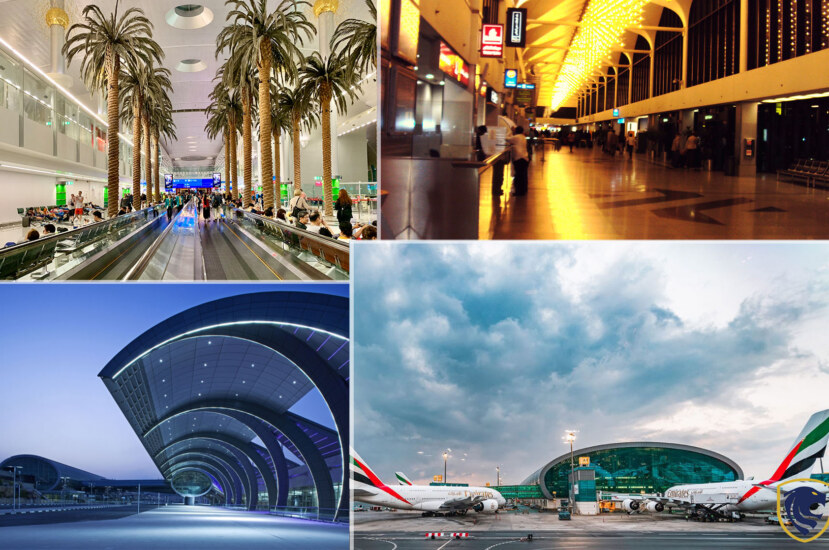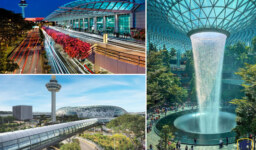The main international airport in Dubai is United Arab Emirates. This airport also happens to be the busiest in the world in terms of international passenger traffic. Moreover, it is one of the biggest airports worldwide for cargo. Also, it is considered the main international airport for Airbus A380 and Boeing 777 movements. Moreover, it has the airport with the greatest average number of people per flight. 88 million passengers, 2.65 million tonnes of cargo, and 409,493 aircraft movements were handled at the airport in 2017.
The Al Garhoud neighborhood, 2.5 nautical miles east of Dubai, is home to the 7,200 acres of land that makes up Dubai International Airport. The world’s largest airport terminal, Terminal 3, is also the second-largest facility in terms of floor size. As part of Dubai’s objective to lower the city’s energy usage by 30% by 2030, the biggest solar energy system in the area was established at Dubai International Airport in July 2019.
History of Dubai International Airport
The beginning of civil aviation in Dubai can be traced back to July 1937, when a contract was made to rent a flying boat base to Imperial Airlines’ aircraft for 440 rupees per month. Moreover, once-a-week flights by the Empire Flying Boats began. Usually, there were direct flights from the UK to Southampton, England, going east to Karachi. Further, there were four flying boats each week by February 1938.

History of Dubai International Airport
In the 1940s, British Overseas Airlines Corporation (BOAC) flew from Dubai using flying boats to travel the Horseshoe route from Southern Africa to the Persian Gulf to Sydney.
Constructions
Shaikh Rashid bin Saeed Al Maktoum, the ruler of Dubai, gave the authority to build the airport in 1959. It was equipped to accommodate aircraft up to the size of a Douglas DC-3 on a 1,800-metre-long runway. This runway is composed of compacted sand when it initially opened for business in 1960. The airport that Costain built was finished with three turning areas, an apron, and a modest terminal.
A 2,800 m asphalt runway was first built in May 1963. This second runway, together with the existing sand runway and taxiway, were both inaugurated in May 1965. In addition, the Terminal Building had many major additions. Hangars were built, and airport and navigational aids were installed. After the ceremonial inauguration, the lighting system installation continued and was finished in August of that same year.

Constructions
Several expansions and equipment improvements, including a VHF omnidirectional range (VOR) and an instrument landing system (ILS) were established. Moreover, new buildings were built in the second part of the 1960s. Nine airlines were operating out of the airport in 1969, with a total of 20 destinations. The first major planes from Middle East Airlines and Kuwait Airways Comets visited to honor the occasion on May 15, 1966.
Infrastructure
The original long-term plan for the current airport had provisions for two additional passenger terminals shortly. It was planned to build along with a dual-terminal and one-runway layout across two stages. Further, phase 1 of the project saw the creation of the first passenger terminal. It also included the first runway, 70 parking spaces for aircraft, and various support structures.

Infrastructure
Such as an airfreight complex, two cargo agent buildings, and a sizable maintenance hangar. In addition, there is the first fire station, workshops, and administrative offices, as well as an 87 m (285 ft) control tower and an in-flight food facility. The second runway has 50 additional aircraft parking spaces in addition to the existing 70 spaces. A second fire station and a third cargo agent building would all be included in the second phase’s construction. These would start as soon as Phase 1 was finished.
proposals in the early 2000s
A new terminal, 60 extra parking spaces, a new aircraft maintenance facility, and portions of Terminal 1’s main structure and Concourse C were also built during the third phase. A new plan was then proposed in the early 2000s.
The expansion of the existing concourses and terminal infrastructure was first proposed in a new master plan.

Infrastructure of Dubai international airport
In an interview with Vision magazine, Paul Griffiths, the CEO of Dubai Airports, mentioned intentions to construct infrastructure to support the growth of Emirates and low-cost carrier flydubai, as well as Dubai Airports’ ascent to the status of a major international aviation hub.
Terminals
Three terminals are present at Dubai International Airport. A general aviation terminal (GAT) lies nearby, and the freight terminal can handle 3 million tonnes of cargo yearly.
Terminal 1
A 45 million passenger capacity is available at Terminal 1. It is utilized by more than 100 airlines, and an automatic passenger mover connects it to Concourse D. It has 221 check-in counters.

Terminal 1
While the terminal was designed to hold 18 million people, it became so overcrowded that the airport was obliged to enlarge it to make room for the inauguration of 28 distant gates. The airport now has 28 mobile gates in total as of 2010. Other mobile gates have been installed throughout the years.
Terminal 2
With a size of 47,000 m2 and a capacity of 10 million as of 2013, Terminal 2 has undergone several respectable repairs and a significant extension that saw the facility’s capacity quadruple. It is used by around 50 airlines, mostly operating in the Persian Gulf region. Further, most flights go to Pakistan, Afghanistan, Iran, Saudi Arabia, and India.

Terminal 2
Air India Express and flydubai made Terminal 2 their hub in June 2009. Also, this terminal serves as the location of the airline’s corporate headquarters.
Terminal 3
With a 65 million passenger capacity, Terminal 3 was constructed for US$4.5 billion exclusively for Emirates. There are 20 Airbus A380 gates in Concourse A, 5 in Concourse B, and 2 in Concourse C of the facility. On September 6, 2012, it was revealed that Terminal 3 will no longer be exclusively used by Emirates since Qantas and Emirates had established a comprehensive code-sharing arrangement.

Terminal 3
Shopping at Dubai International Airport
Before you fly, indulge in a tax-free shopping spree. In Emirates Terminal 3, you may discover recently released perfumes, smartwatches, and dazzling jewelry. You can browse boutique clothing at discount prices from popular clothing retailers. Moreover, there you can find premium labels like Bulgari, Chanel, and Carolina Herrera. Fill up on cosmetics and beauty supplies, or treat yourself to a new camera or phone at rates that are lower than those at the mall. Only a short stroll from your departure gate, you may choose from a wide selection of mementos and customary presents that are sure to make someone smile.
fine vintage
Satisfy your appetite for exquisite vintages at Le Clos’s fine wine and luxury liquor shop. There you can ask the Le Clos specialists to assist you in selecting the ideal bottle to suit your preferences as you explore specialties and limited editions from across the globe.

Shopping at Dubai International Airport
Emirates Official Store
Bring a memento of your trip with you or purchase an Emirates collectible. Moreover, at our official store, you can buy cool gifts, travel items, and apparel bearing the Emirates logo.
Food and drink
You can spend a little more on a fancy lunch or get a fast snack before you take off. Also, you have many options such as renowned eateries, smoothie shops, and cozy cafés.

Shopping at Dubai International Airport
Flower Centre
As Dubai is a significant hub for the import and export of flowers, Dubai Airport built a flower center to manage these shipments. Since these items require specific handling, the airport needed a specialized facility. So, the $50 million initial phase of the flower center was finished in 2004.
The center will have a floor space of around 100,000 m2. It is finished and operational, containing several export chambers and offices. More than 300,000 tonnes of product throughput per year are anticipated to be handled by the center annually.




